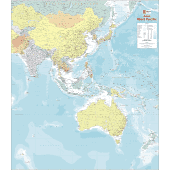Asia-Pacific view
According to Strategy Analytics’ “Global Mobile Workforce Forecast”, the global mobile workforce is set to increase to 1.88 billion in 2023, accounting for 43.3% of the global workforce. With a future comprising a mobile workforce on the horizon we draw focus to the highly-anticipated workforce mobility trends HR leaders based in Singapore and Malaysia foresee for the year ahead.
- Mobility will be a balancing act among various needs
According to Selvi Murugiah, HR Director Asia Pacific, Veolia Water (Malaysia) Holding, as the world shrinks and borders disappear – with international businesses and multinationals mushrooming around the globe – mobility has become a norm for any business. In fact, she believes mobility even takes on a bigger scope than HR or talent. She said: “Mobility is also about mobilising funds, technology, expertise, mindset, culture and all relevant and related needs that will take centre stage. This is unavoidable and if not handled with care or well-thought, it can be a disaster!
“The solution is balance. We need to balance the need/want of the company with not only the need of the employees, but also the country or society and the economy as a whole. The ecosystem needs to be balanced not only with dollar and cents but also with values and the post-effect of any mobility.”
Connie Chua, Head of HR, Worldline Asia Pacific, shares the viewpoint. She said: “Technically, employee mobility should be a focal point in years to come. However, we have to strike a balance between business demands and the cost of mobility. On top, managing mobility and understanding each and every local regulatory requirement is critical and time-consuming.”
- Well-defined, end-to-end mobility objectives
Selvi from Veolia Water (Malaysia) believes it is important for the objective of mobility to be well-defined and that the process should be end-to-end – from pre-to-post remuneration package, career development, transfer of knowledge, employee satisfaction, company requirements, country-related laws more.
- Transfer of knowledge and skills from foreign to local talent
Sometimes, a global organisation in a particular country may lack a skilled manpower, resources to train their existing employees for specific skills and knowledge. In such cases, companies may mobilise certain employees overseas – either permanently or for a limited period – to facilitate the transfer of knowledge and skills to employees over there.
According to Lyn Teo, Senior HR Business Partner / CoE, Recruitment (ASEAN), TÜV SÜD PSB, this is becoming increasingly common within organisations. She shared: “With a lot of this support coming from the Government in terms of capability transfer, capability development, I think organisations are planning and initiating the skill transfer rather than doing it randomly.”
As for Veolia Water (Malaysia), the company is undertaking a training programme for employees, which it will over the next 12 months. Selvi affirmed: “We are focusing on the transfer of knowledge from the imported or visiting experts and growing those expertise for local needs, to also contribute back to this mobility cycle.”
- Permanent transfers will keep growing as a trend …see infographic below
According to an ECA International survey on permanent transfers, with companies seeking flexible and cost-effective alternatives to traditional long-term assignments in mobilising their employees, there has been an increase in permanent international transfers.
As a result, survey findings show that companies will increasingly depend on their global mobility team’s expertise, with well-structured and flexible policies introduced to facilitate this effectively.
As companies seek flexible and cost-effective alternatives to traditional long-term assignments to mobilise their staff, the use of permanent international transfers has increased. A recent ECA survey found that nearly two-thirds of companies saw an increase in the number of permanent transfers as a proportion of all their international moves in the last three years. They also expected the proportion to continue increasing going forwards.
The relative cost-effectiveness of permanent transfers compared to other assignment types is driving the trend. Transferees are most commonly paid a host-based salary and fewer of the additional benefits and allowances that are typically paid to assignees. However, while permanent transfers may appear to be cheaper than assignments on paper, around half of the companies surveyed reported that ensuring the salary package was competitive enough to encourage mobility presented a significant challenge. Where the employee is not sufficiently motivated by the career opportunity on offer or a personal desire to move abroad, companies need to be flexible and allow further incentives, which increase the cost. Rather than replacing other assignment types completely, permanent transfers are often most effectively used alongside other mobility policies, with different approaches used to suit different mobility scenarios.
While flexibility is important, almost half of companies have no policy for their permanent transfers at all, significantly higher than the number of companies with no long-term assignment policy. In fact, a similar proportion of companies do not involve their global mobility team in managing permanent transfers at all, which may explain why applying policy consistently and managing employee expectations are also cited as major challenges when managing permanent transfers. Although companies want to use permanent transfers because of their cost-effectiveness, an inconsistent approach where packages are essentially negotiated with the individual can lead to unnecessary expenditure which erodes that advantage.
As the use of permanent transfers grows, we expect companies increasingly to depend on the expertise of their global mobility teams to administer them and that they will need structured yet flexible policies in place to do this effectively. Our Permanent Transfers survey, highlights of which are shown below, identifies trends and best practice in compensation and benefits for this kind of mobile employee, including differences between employee- and company-initiated transfers. As always, ECA’s consultants are also on hand to help you develop or review your permanent transfers policy according to your specific needs and in line with best practice.





